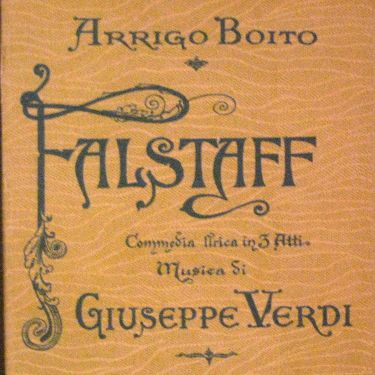
Overview
Synopsis
The fat, old knight, Falstaff, seeks to seduce two married women in order to steal some money, and have a little fun. Alice and Meg receive the letters of invitation, shocked that the fat, old man would expect them to swoon, and amused because they have both received the exact same letter. Seeking to punish Falstaff, they plan to make a fool of him, letting him think, for a while, that they have accepted. Ford, Alice’s husband, discovers Falstaff’s plan, but is not in on the prank that Alice is plotting, therefore believing himself to be betrayed. As multiple plots coincide, Falstaff is at the center of the chaos and mixed communication. Hilariously, all come together against Falstaff and succeed in making him a fool, and showing him the wrong in his ways. They all laugh together in the end, and declare that “he who laughs last, laughs best.”
Show Information
Context
Verdi had already gone into retirement when Boito brought the idea of Falstaff to him. Boito adapted the libretto from Shakespeare’s The Merry Wives of Windsor, and Henry IV. Boito changes the focus a bit, making Falstaff a much larger presence by taking large scenes and monologues from Henry IV, and decreasing the cast size of The Merry Wives of Windsor to focus mainly on Alice and Ford. Verdi did, in fact, come out of retirement to work for three years on the development of the
to read the context for Falstaff and to unlock other amazing theatre resources!Plot
Act I, Part I
The knight, Falstaff, is sealing a few letters at the Garter Inn when Dottor Cajus enters, screaming, accusing him of having beat his servants and worn out his horse. Falstaff is barely aware of the Dottor, and shoves him off, causing Dottor Cajus to turn on Bardolfo and Pistola, Falstaff’s servants, who got him so drunk that they robbed him. They incredulously deny the claim, and Dottor Cajus leaves in a huff, stating he will only drink so much around good, upstanding
to read the plot for Falstaff and to unlock other amazing theatre resources!Characters
| Name | Part Size | Gender | Vocal Part |
|---|---|---|---|
|
Lead |
Male |
Baritone |
|
|
Lead |
Male |
Baritone |
|
|
Lead |
Female |
Soprano |
|
|
Supporting |
Female |
Mezzo-Soprano |
|
|
Supporting |
Female |
Soprano |
|
|
Supporting |
Female |
Tenor |
|
|
Supporting |
Female |
Mezzo-Soprano |
|
|
Featured |
Male |
Tenor |
|
|
Featured |
Male |
Tenor |
|
|
Featured |
Male |
Bass |
|
|
Ensemble |
Either Gender |
|
Songs
Act I
- Parte prima (Dottor Cajus, Bardolfo, Pistola, Falstaff)
- Parte seconda (Alice, Nannetta, Meg, Quickly, Ford, Fenton, Dottor Cajus, Bardolfo, Pistola)
Act II
- Parte prima (Bardolfo, Pistola, Falstaff, Quickly, Ford)
- Parte seconda (Alice, Meg, Quickly, Nannetta, Falstaff, Ford, Bardolfo, Pistola, Fenton, Dottor Cajus, Coro)
Act III
- Parte prima (Falstaff, Quickly, Alice, Nannetta, Ford, Dottor Cajus, Meg, Fenton)
- Parte seconda (Fenton, Nannetta, Alice, Meg, Quickly, Falstaff, Bardolfo, Pistola, Ford, Dottor Cajus, Coro)
A song with an asterisk (*) before the title indicates a dance number; a character listed in a song with an asterisk (*) by the character's name indicates that the character exclusively serves as a dancer in this song, which is sung by other characters.
Monologues
Scenes
Key Terms
Sorry! We do not currently have terms for this guide.
Videos
Quizzes
Sorry! We do not currently have quizzes for this guide.
Themes, Symbols & Motifs
Sorry! We do not currently have learning modules for this guide.
Quote Analysis
Sorry! We do not currently have learning modules for this guide.
